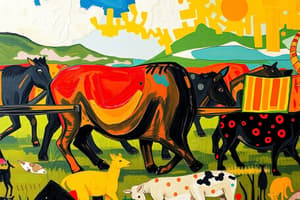Podcast
Questions and Answers
What factor contributes to the faster growth of small populations compared to large populations?
What factor contributes to the faster growth of small populations compared to large populations?
- Density-dependent factors (correct)
- Random environmental changes
- Limited resource availability
- Density-independent factors
What is a primary reason small populations are more vulnerable to extinction?
What is a primary reason small populations are more vulnerable to extinction?
- They experience less competition for resources.
- They are more affected by density-independent factors. (correct)
- Their growth rates are consistently higher.
- They have more available habitat space.
Which phenomenon is highlighted as contributing to the greater extinction rates seen on smaller islands?
Which phenomenon is highlighted as contributing to the greater extinction rates seen on smaller islands?
- Limited food resources
- Increased genetic diversity
- Higher breeding success
- Greater vulnerability to chance events (correct)
In what way do small populations of plants in Germany demonstrate vulnerability to extinction?
In what way do small populations of plants in Germany demonstrate vulnerability to extinction?
How does density-dependent population growth differ between smaller and larger populations?
How does density-dependent population growth differ between smaller and larger populations?
What is a characteristic of deterministic models in population growth?
What is a characteristic of deterministic models in population growth?
What does demographic stochasticity refer to?
What does demographic stochasticity refer to?
In a stochastic model, what is the outcome of many consecutive years of below-average growth?
In a stochastic model, what is the outcome of many consecutive years of below-average growth?
How does population size affect the probability of extinction?
How does population size affect the probability of extinction?
What is the primary difference between demographic and environmental stochasticity?
What is the primary difference between demographic and environmental stochasticity?
What is the effect of patch size on extinction rates in metapopulations?
What is the effect of patch size on extinction rates in metapopulations?
How does isolation affect patch occupancy in metapopulations?
How does isolation affect patch occupancy in metapopulations?
What is the 'rescue effect' in the context of metapopulations?
What is the 'rescue effect' in the context of metapopulations?
Which statement accurately reflects the occupation likelihood of skipper butterflies in relation to patch size and distance?
Which statement accurately reflects the occupation likelihood of skipper butterflies in relation to patch size and distance?
What percentage of patches were monitored for colonization and extinction in the study of the Glanville fritillary butterfly?
What percentage of patches were monitored for colonization and extinction in the study of the Glanville fritillary butterfly?
What affects population dynamics according to their body size?
What affects population dynamics according to their body size?
Which factor can lead to a cyclic population size?
Which factor can lead to a cyclic population size?
What is a consequence of small population sizes in terms of extinction?
What is a consequence of small population sizes in terms of extinction?
What typically happens to populations during an overshoot?
What typically happens to populations during an overshoot?
How can fluctuations in age structure indicate past population dynamics?
How can fluctuations in age structure indicate past population dynamics?
What allows small organisms to quickly respond to environmental conditions?
What allows small organisms to quickly respond to environmental conditions?
What typically causes a die-off in a population?
What typically causes a die-off in a population?
What is a metapopulation characterized by?
What is a metapopulation characterized by?
What is the likely consequence of a population overshooting its carrying capacity?
What is the likely consequence of a population overshooting its carrying capacity?
How does delayed density dependence influence population cycling?
How does delayed density dependence influence population cycling?
Which mathematical relationship indicates no oscillations in population size?
Which mathematical relationship indicates no oscillations in population size?
What is a characteristic of populations with damped oscillations?
What is a characteristic of populations with damped oscillations?
Which factor can influence the time delay in density dependence?
Which factor can influence the time delay in density dependence?
What is likely to happen to a population with a high intrinsic growth rate and a long time delay?
What is likely to happen to a population with a high intrinsic growth rate and a long time delay?
How does resource storage in Daphnia galeata affect their population dynamics?
How does resource storage in Daphnia galeata affect their population dynamics?
What defines a stable limit cycle in population cycling?
What defines a stable limit cycle in population cycling?
Which of the following best describes the concept of carrying capacity?
Which of the following best describes the concept of carrying capacity?
What characterizes metapopulations?
What characterizes metapopulations?
What is a feature of the basic metapopulation model?
What is a feature of the basic metapopulation model?
How can metapopulations occur due to human activities?
How can metapopulations occur due to human activities?
What do source subpopulations provide in the source-sink metapopulation model?
What do source subpopulations provide in the source-sink metapopulation model?
Which statement describes how the landscape metapopulation model differs from the source-sink model?
Which statement describes how the landscape metapopulation model differs from the source-sink model?
What does an increase in colonization rates in a metapopulation indicate?
What does an increase in colonization rates in a metapopulation indicate?
Which factor influences the proportion of occupied patches at equilibrium in metapopulations?
Which factor influences the proportion of occupied patches at equilibrium in metapopulations?
In a metapopulation, what effect does decreasing extinction have?
In a metapopulation, what effect does decreasing extinction have?
What can be inferred about the relationship between colonization and extinction rates in nature?
What can be inferred about the relationship between colonization and extinction rates in nature?
Flashcards
Population dynamics
Population dynamics
The changes in a population's size over time or space.
Carrying capacity
Carrying capacity
The average number of individuals of a species that a given environment can sustainably support.
Overshoot
Overshoot
A temporary increase in population size beyond the carrying capacity of the environment.
Die-off
Die-off
Signup and view all the flashcards
Doubling time
Doubling time
Signup and view all the flashcards
Population growth rate
Population growth rate
Signup and view all the flashcards
Limiting factor
Limiting factor
Signup and view all the flashcards
Density-dependent factor
Density-dependent factor
Signup and view all the flashcards
Population cycles
Population cycles
Signup and view all the flashcards
Carrying capacity (K)
Carrying capacity (K)
Signup and view all the flashcards
Time delay (τ)
Time delay (τ)
Signup and view all the flashcards
Intrinsic growth rate (r)
Intrinsic growth rate (r)
Signup and view all the flashcards
Delayed density dependence
Delayed density dependence
Signup and view all the flashcards
Damped oscillations
Damped oscillations
Signup and view all the flashcards
Stable limit cycle
Stable limit cycle
Signup and view all the flashcards
rτ product
rτ product
Signup and view all the flashcards
Modified logistic growth model
Modified logistic growth model
Signup and view all the flashcards
Energy buffer
Energy buffer
Signup and view all the flashcards
Small populations are more vulnerable to extinction.
Small populations are more vulnerable to extinction.
Signup and view all the flashcards
Allee effect
Allee effect
Signup and view all the flashcards
Population growth rate variability
Population growth rate variability
Signup and view all the flashcards
Why don't small populations recover?
Why don't small populations recover?
Signup and view all the flashcards
Deterministic model
Deterministic model
Signup and view all the flashcards
Stochastic model
Stochastic model
Signup and view all the flashcards
Demographic stochasticity
Demographic stochasticity
Signup and view all the flashcards
Environmental stochasticity
Environmental stochasticity
Signup and view all the flashcards
Population size and extinction probability
Population size and extinction probability
Signup and view all the flashcards
Habitat Quality
Habitat Quality
Signup and view all the flashcards
Isolation and Extinction
Isolation and Extinction
Signup and view all the flashcards
Patch size and population
Patch size and population
Signup and view all the flashcards
Small patch extinction
Small patch extinction
Signup and view all the flashcards
Metapopulation
Metapopulation
Signup and view all the flashcards
Source subpopulation
Source subpopulation
Signup and view all the flashcards
Sink subpopulation
Sink subpopulation
Signup and view all the flashcards
Landscape metapopulation model
Landscape metapopulation model
Signup and view all the flashcards
Patch occupancy
Patch occupancy
Signup and view all the flashcards
Colonization rate
Colonization rate
Signup and view all the flashcards
Extinction rate
Extinction rate
Signup and view all the flashcards
Metapopulation equilibrium
Metapopulation equilibrium
Signup and view all the flashcards
Habitat fragmentation
Habitat fragmentation
Signup and view all the flashcards
Basic metapopulation model
Basic metapopulation model
Signup and view all the flashcards
Study Notes
Lecture 13: Population Dynamics Over Time and Space
-
Population size fluctuates naturally over time.
-
Population dynamics describe variation in population size over time or space.
-
Population dynamics can be relatively stable or widely fluctuating.
-
Differences in body size, population response time, and sensitivity to environmental change affect population dynamics.
-
Small organisms (e.g., algae) reproduce quickly (hours), allowing quick responses to environmental changes.
-
Small organisms have a high surface-area-to-volume ratio, making them sensitive to environmental changes.
-
Larger, longer-lived species have longer generation times and include many age classes.
-
Fluctuations in birth rates have less impact on the growth of larger, longer-lived species.
-
Populations maintain homeostasis (less sensitive to environmental change).
-
Age structure can fluctuate.
-
If a specific age group has unusually high or low numbers, the population experienced unusually high or low birth or death rates in the past.
-
Example: whitefish (Coregonus clupeaformis).
Overshoots and Die-offs
- Populations can temporarily exceed carrying capacity (overshoot).
- Overshoots can occur when carrying capacity decreases.
- A die-off is a substantial decline in population density.
- Populations typically go well below carrying capacity after a die-off.
- Example: Reindeer on St. Paul Island (25 individuals introduced in 1911, exponential growth, massive die-off in 1938, now maintained at ~400 individuals).
Density Dependence with Time Delays
- Density dependence with time delays can cause population size to be inherently cyclic.
- Some populations experience regular patterns of fluctuations (population cycles).
- Example: Gyrfalcon exports match natural population cycles.
- Populations fluctuate above and below carrying capacity.
- At carrying capacity, populations are stable.
- When population decreases (predation, disease), growth starts.
Delayed Density Dependence
- Delayed density dependence occurs when density dependence occurs based on a past population density.
- It can be caused by factors related to carrying capacity, such as long gestation periods or predator response times.
- Example: Moose breed in fall but don't give birth in spring; available resources may be different by then.
Modeling Delayed Density Dependence
- Delayed density dependence can be modeled with a modified logistic growth model equation.
- Whether a population cycles depends on the time delay (τ) and the intrinsic growth rate (r).
- As time delay increases, density dependence is further delayed, making the population more prone to overshooting/undershooting carrying capacity.
- A high intrinsic growth rate increases the chance of overshoot.
Modeling Delayed Density Dependence: Cycling
- The amount of cycling depends on the product of r and τ.
- When rt is low (rt < 0.37), no oscillations occur. Example: a graph showing a gradually increasing growth.
- When rt is intermediate (0.37 < rt < 1.57), damped oscillations occur. There is ongoing fluctuation. Growth then reduces, and starts to grow again.
- When rt is high (rt > 1.57), stable limit cycle occurs. Large oscillations persist over time (a cyclical graph pattern).
Population Sizes Cycle in Laboratory Populations
- Example: Daphnia galeata; Bosmina longirostris.
- When population is low and food abundant, individuals store excess food droplets.
- Although growing, populations deplete resources but still reproduce because of stored food droplets.
- Causes the populations to overshoot, then die off.
- Bosmina longirostris do not store many lipid droplets, cannot reproduce beyond carrying capacity.
Extinction in Small Populations
- Small populations are more vulnerable to extinction than large ones.
- Small populations are vulnerable to both density-independent factors (e.g., natural disasters) and density-dependent factors (Allee effects).
- Relationship between population size and probability of extinction.
- Example: Birds in the Channel Islands, extinction rates were greater on smaller islands.
- Example: Plant populations in Germany, sampled over 10 years, smaller populations are likely to go extinct.
Extinction Due to Variation in Population Growth Rates
- Density-dependent population models show that small populations initially grow more rapidly than large ones.
- But, small populations are more likely to go extinct due to random environmental variation in birth/death rates.
- Stochastic models incorporate random variations in population growth rates.
- Stochasticity varies between demographic (differences among individuals) and environmental (changes in environmental conditions like weather).
Metapopulations
- Population dynamics vary over space.
- Populations are often divided into subpopulations.
- Subpopulations are smaller groups of conspecifics in isolated patches.
- Dispersal among subpopulations is infrequent; dynamics are independent.
- A collection of subpopulations forms a metapopulation.
The Fragmented Nature of Habitats
- Metapopulations can occur when habitat is naturally patchy.
- Example: Wetlands in North America; terrestrial habitat often inhospitable, minimal dispersal between water bodies.
- Metapopulations can also occur due to human activities.
- Example: Habitat fragmentation; breaking large habitats into smaller ones.
Conceptual Models of Spatial Structure
- Three models for spatial structure of subpopulations: Basic metapopulation model, Source-sink metapopulation model, Landscape metapopulation model.
The Basic Metapopulation Model
- Describes a scenario with patches of suitable habitat embedded in unsuitable habitat.
- All suitable patches are equally good.
- Some patches are occupied, others not.
- Unoccupied patches can be colonized by dispersers.
- The model emphasizes how colonization and extinction events affect the proportion of suitable habitats.
The Source-Sink Metapopulation Model
- Builds on the basic model, including variation in patch quality.
- Source subpopulations are high-quality habitats with dispersers.
- Sink subpopulations are low-quality habitats; outside dispersers maintain the subpopulation.
The Landscape Metapopulation Model
- Builds on the source-sink model by including variation in unsuitable habitat around patches.
The Basic Dynamics of Metapopulations
- Assume patches are equal quality. The same subpopulation size and the same number of dispersers.
- Some proportion of the habitats will be occupied (p).
- Fixed probability that a patch becomes unoccupied through extinction (e).
- Fixed probability of colonization (c).
Observing Metapopulation Dynamics in Nature
- Do we see a balance of colonization/extinction rates in nature?
- Example: Glanville fritillary butterfly (Melitaea cinxia); lives in isolated patches of dry meadows.
- Monitored extinction/colonization of 1600; 12-39% occupied over a 9-year period; ~100 colonized, ~100 extinct.
Patch Size and Isolation
- Habitat patches rarely have equal quality.
- Larger patches typically support more individuals.
- Example: California spotted owl (Strix occidentalis occidentalis).
- Smaller patches experience higher extinction rates.
- Distance between patches affects the rate of patch colonization.
- Less isolated patches could be supported by nearby dispersers = rescue effect.
- Example: skipper butterflies (Hesperia comma).
Studying That Suits You
Use AI to generate personalized quizzes and flashcards to suit your learning preferences.




